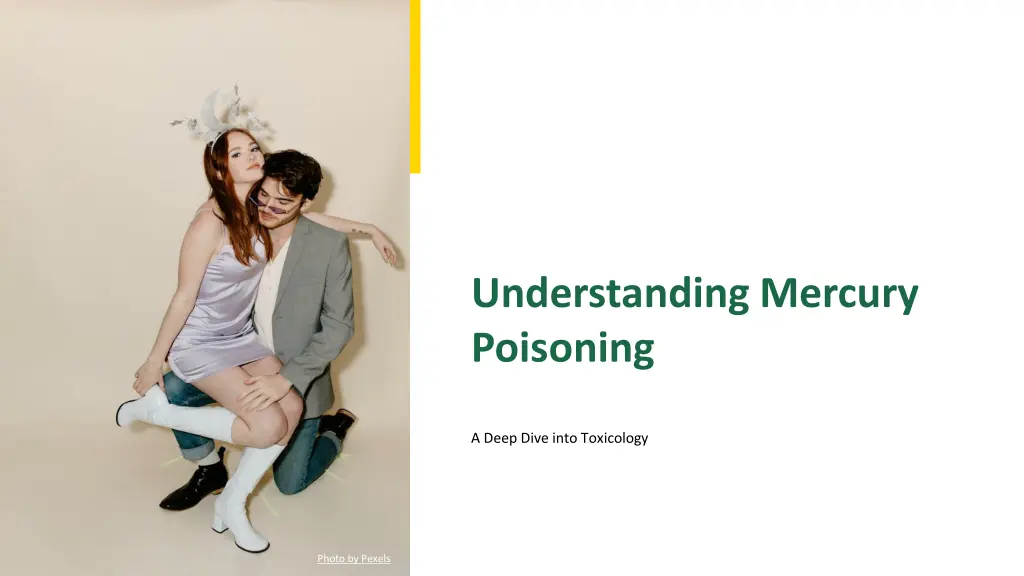
Understanding Mercury Poisoning: Sources, Effects, and Prevention
Explore the risks of mercury poisoning, its sources, health effects, and preventive measures in this in-depth guide to toxicology. Learn how to recognize symptoms, diagnose, treat, and prevent exposure to safeguard public health.
Download Presentation

Please find below an Image/Link to download the presentation.
The content on the website is provided AS IS for your information and personal use only. It may not be sold, licensed, or shared on other websites without obtaining consent from the author. If you encounter any issues during the download, it is possible that the publisher has removed the file from their server.
You are allowed to download the files provided on this website for personal or commercial use, subject to the condition that they are used lawfully. All files are the property of their respective owners.
The content on the website is provided AS IS for your information and personal use only. It may not be sold, licensed, or shared on other websites without obtaining consent from the author.
E N D
Presentation Transcript
Understanding Mercury Poisoning A Deep Dive into Toxicology Photo by Pexels
01 What is Mercury Poisoning? Table of Contents 02 Sources of Mercury 03 Types of Mercury Exposure 04 Health Effects of Exposure 05 Signs and Symptoms 06 Diagnosis and Testing 07 Treatment Options 08 Preventing Exposure 09 Mercury Regulations 10 Community Awareness 11 Thank You!
1 What is Mercury Poisoning? Defining the Issue Mercury poisoning is a toxic reaction caused by excessive exposure to mercury, a naturally occurring elemental metal. It often emerges from various environmental sources, including air, water, and certain foods, accumulating in bodies over time. Understanding its implications is crucial for public health and safety, as it can lead to severe health issues. Awareness and education are key factors in preventing mercury exposure and its subsequenthealth risks. Photo by Pexels
2 Sources of Mercury Where Does It Come From? Mercury is released into the environment through industrial processes, such as coal burning and mining activities. Natural sources include volcanic eruptions and weathering of mercury-containing rocks, adding to its environmental presence. Fish and seafood can also accumulate mercury, placing consumers at risk, especially vulnerable populations like children and pregnantwomen. Identifying these sources is vital to managing exposure and protectinghealth. Photo by Pexels
3 Types of Mercury Exposure Different Forms Matter There are three primary forms of mercury: elemental, inorganic, and organic, each posing different health risks. Elemental mercury is found in thermometers and certain types of light bulbs, and can be harmful when vaporized. Inorganic mercury often comes from industrial processes, while organic mercury typically originates in seafood. Each type requires specific preventive measures to limit exposure and ensure safety. Photo by Pexels
4 Health Effects of Exposure What Happens to Us? Mercury poisoning can lead to neurological and physical health problems, affecting both adults and children significantly. Common symptoms include tremors, insomnia, memory loss, and muscle weakness, indicatingserious underlying issues. Prolonged exposure may damage the kidneys and lungs, leading to chronic health conditions over time. Understanding these effects is essential for recognizing the dangers and seeking prompt treatment. Photo by Pexels
5 Signs and Symptoms Recognizing the Danger Symptoms can vary based on the type and duration of exposure, making early recognition critical. Common signs include irritability, excessive shyness, and changes in vision and hearing, among others. Doctors often rely on patient history and symptom presentation to diagnose mercury poisoning effectively. Awareness of these symptoms can facilitate early medical intervention and improved outcomes. Photo by Pexels
6 Diagnosis and Testing How Is It Identified? Diagnosis typically begins with a thorough medical history and a physical examination by a healthcare provider. Laboratory tests, including blood and urine tests, help confirm mercury levels in the body. Advanced imaging techniques may be used to assess organ damage, particularly in the nervous system. Timely diagnosis can lead to more effective treatment plans and recovery strategies. Photo by Pexels
7 Treatment Options Managing Mercury Poisoning Treatment primarily focuses on reducing mercury levels in the body and managing symptoms effectively. Chelation therapy is commonly utilized to bind mercury and facilitate its removal from the body. Supportive care, including physical therapy, may also be necessary to aid recovery from neurological impacts. An integrated approach to treatment enhances patient outcomes and overall health recovery. Photo by Pexels
8 Preventing Exposure Staying Safe Preventing mercury poisoning involves reducing exposure from known sources and improving environmental practices. Public education campaigns play a crucial role in raising awareness about the risks and preventive measures. Regular monitoring of at-risk communities helps ensure safety and prompt intervention where necessary. Empowering communities with knowledge can significantly lower the incidence of mercury poisoning. Photo by Pexels
9 Mercury Regulations Legal Framework Various regulations exist worldwide to limit mercury emissions and protect public health. International agreements, such as the Minamata Convention, aim to phase out the use of mercury in many industries. Stronger enforcement of existing laws is essential for safeguardingcommunities from mercury-relatedrisks. Understanding these regulations can help individuals advocate for safer environments. Photo by Pexels
10 Community Awareness Spreading the Word Community awareness initiatives are vital for educating the public about mercury dangers. Workshops, informational materials, and outreach programs can empower individuals to act on safety measures. Engaging local leaders and stakeholders enhances the effectiveness of awareness campaigns. A well-informed community can reduce exposure and protect public health effectively. Photo by Pexels
11 Thank You! Stay Informed Thank you for engaging with our presentation on mercury poisoning and toxicology. Your awareness and understanding can contribute to preventingmercury exposure in our communities. Let s work together for a healthier and safer environment for everyone. Photo by Pexels
